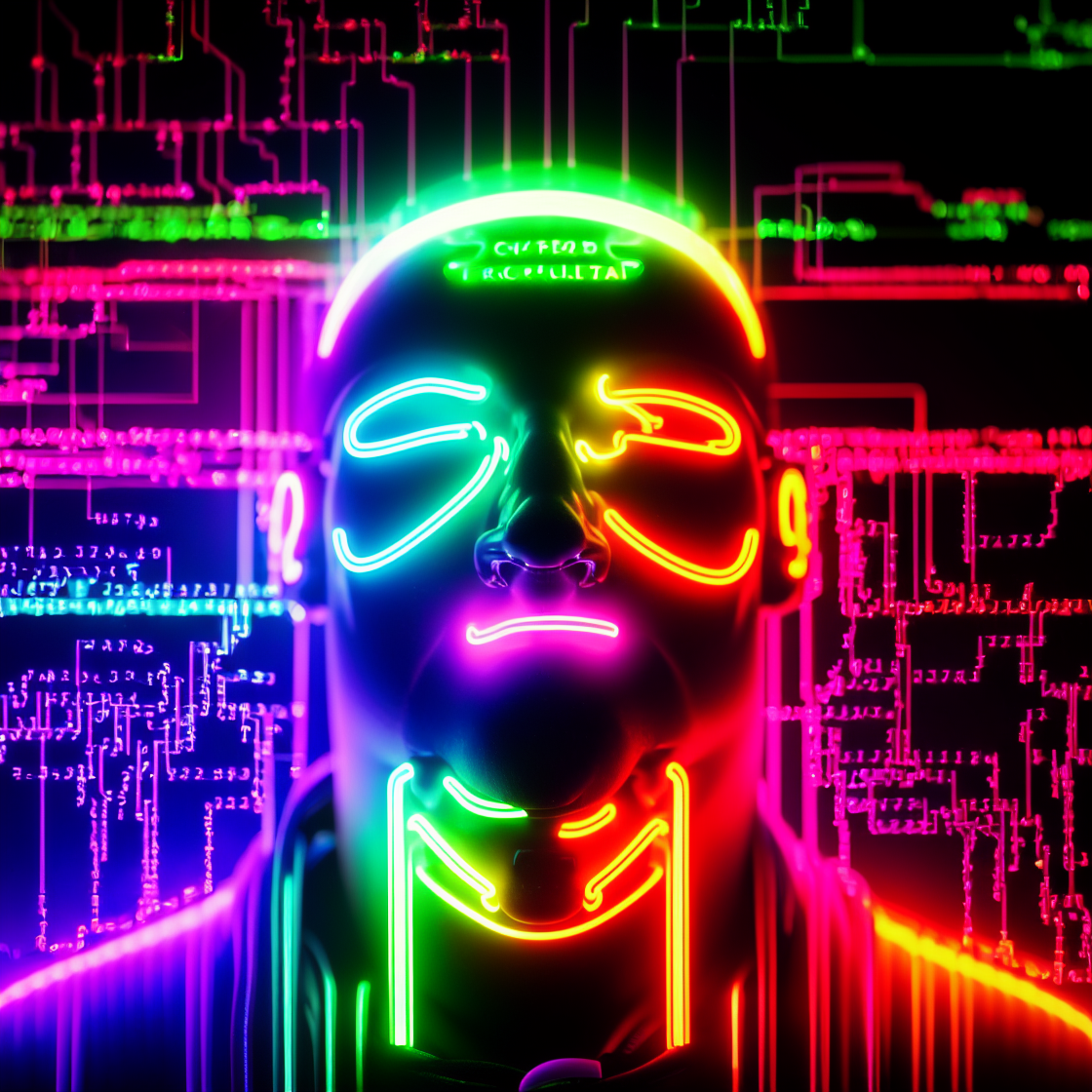I would be in trouble if this was a thing. My writing naturally resembles the output of a ChatGPT prompt when I’m not joke answering or shitposting.
We found the source
I would be in trouble if this was a thing. My writing naturally resembles the output of a ChatGPT prompt when I’m not joke answering.
It’s not unusual for well-constructed human writing to resemble the output of advanced language models like ChatGPT. After all, language models like GPT-4 are trained on vast amounts of human text, and their main goal is to replicate and generate human-like text based on the patterns they’ve observed.
/gpt-4
Be me
well-constructed human writing
You guys?! 🤗
deleted by creator
Do you also need help from a friend to prove you are not a robot?
I need a lotta help, just not from a friend and about anything robot-related 😮💨
Hope you have some good friends and family that can help.
deleted by creator
they never did, they never will.
Why tho or are you trying to be vague on purpose
Because you’re training a detector on something that is designed to emulate regular languages closest possible, and human speech has so much incredible variability that it’s almost impossible to identify if someone or something has been written by an AI.
You can detect maybe your typical generic chat GPT type outputs, but you can characterize a conversation with chat GPT or any of the other much better local models (privacy and control are aspects which make them better) and after doing that you can get radically human seeming outputs that are totally different from anything chat GPT will output.
In short, given a static block of text it’s going to be nearly impossible to detect if it’s coming from an AI. It’s just too difficult to problem, and if you’re going to solve it it’s going to be immediately obsolete the next time someone fine tunes their own model
Yeah this makes a lot of sense considering the vastness of language and it’s imperfections (English I’m mostly looking at you, ya inbred fuck)
Are there any other detection techniques that you know of? Wb forcing AI models to have a signature that is guaranteed to be indentifiable, permanent, and unique for each tuning produced? It’d have to be not directly noticeable but easy to calculate in order to prevent any “distractions” for the users.
The output is pure text so you would have to hide the signature in the response itself. On top of being useless since most users slightly modify the text after receiving it, it would probably have a negative effect on the quality. It’s also insanely complicated to train that kind of behavior into an llm.
Your implementation of my concept might be useless, but that doesn’t mean the concept is.
One possible solution would be to look at how responses are structured, letter frequencies, etc. The flexibility/ambiguous nature natural language is that you can word things in many many different ways which allows for some creative meta techniques to accomplish a fingerprint.
It is a valid idea, and not impossible. When generating text, a language model gives a list of possible tokens… or more correctly it gives a weight to every possible token where most would be 0 weight. Then there’s multiple ways to pick the next token, from always picking top one to select random from top X tokens to mirostat and so on. You could probably do some extra weighting to embed a sort of signature. At some quality loss
The idea itself is valid, but wouldn’t that just make it more dangerous when malicious agents use the technology without fingerprinting?
Cats out of the bag my friend. Just like the nuke, the ideas are always out there. Once it’s been discovered and shared that’s that.
We can huff and puff and come up with all the cute little laws we want but the fact of the matter is we know the recipe now. All we can do is dive deeper into the technology to understand it even better, make new findings and adapt as we always do.
forcing AI models to have a signature that is guaranteed to be indentifiable, permanent, and unique for each tuning produced
Either AI remains entirely in the hands of fucks like open AI or this is impossible and easily removed. AI should be a free common use tool, not an extension of corporate control.
Agreed, such power should belong to everyone or has yet to be discovered. Even Oppenheimer knew, once the cats out of the bag…
Owning the means of AI production huh? I guess anarchists will win after all.
It’s no different than owning your computer. Something is absolutely a central and productivity boosting is artificial intelligence should not be kept in the hands of the few.
The only way that it could be is through government intervention, you don’t need an anarchist to be against an open AI monopoly.
deleted by creator
Because AIs are (partly) trained by making AI detectors. If an AI can be distinguished from a natural intelligence, it’s not good enough at emulating intelligence. If an AI detector can reliably distinguish AI from humans, the AI companies will use that detector to train their next AI.
I’m not sure I’m following your argument here - you keep switching between talking about AI and AI detectors. Each of the below are just numbered according to the order of your prior responses as sentences:
- Can you provide any articles or blog posts from AI companies for this or point me in the right direction?
- Agreed
- Right…
I’m having trouble finding your support for your claim
See Generative Adversarial Network (GAN). Basically, making new AI detectors will always be harder than beating current ones. AI detectors have to somehow find a new “tell”, the target AI need only train itself on the output of the detector to figure out how to trick it.
ChatGPT isn’t a GAN network.
At a very high level, training is something like:
- generate some output
- give the output a score based on how much it looks like real human text
- adjust the parameters slightly to improve the score
- repeat
Step #2 is also exactly what an “AI detector” does. If someone is able to write code that reliably distinguishes between AI and human text, then AI developers would plug it in to that training step in order to improve their AI.
In other words, if some theoretical machine perfectly “knows” the difference between generated and human text, then the same machine can also be used to make text that is indistinguishable from human text.
Exactly right, I mentioned this in a comment elsewhere but basically we can’t have our cake and eat it too.
We can’t have a perfect NL impersonator that can also be detected as not NL. (Best case, obviously things arent perfect for any AI model so technically detecting those mistakes could be used to help identify perhaps, but who’s to say what the FP rate would look like!)
Ultimately the cat is out of the bag and I’m not quite sure there is anything we can do now. Ultimately some smart fingerprinting solution would be ideal but I just don’t know how feasible that would remain.
Edit: source: I took a few 600 level ai classes in college and have made several of my own of varying types and what not
deleted by creator
Because generative Neural Networks always have some random noise. Read more about it here
Isn’t that article about GANs?
Isn’t GPT not a GAN?
It almost certainly has some gan-like pieces.
Gans are part of the NN toolbox, like cnns and rnns and such.
Basically all commercial algorithms (not just nns, everything) are what I like to call “hybrid” methods, which means keep throwing different tools at it until things work well enough.
The findings were for GAN models, not GAN like components though.
It doesn’t matter. Even the training process makes it pretty much impossible to tell these things apart.
And if we do find a way to distinguish, we’ll immediately incorporate that into the model design in a GAN like manner, and we’ll soon be unable to distinguish again.
Which is why hardcoded fingerprints/identifications are required to identify the individual as a speaker rather than as an AI vs Human. Which is what we’re ultimately agreeing on here outside of the pedantics of the article and scientific findings:
Trying to find the model who is supposed to be human as an AI is counter intuitive. They’re direct opposites if one works, both can’t be exist in this implementation.
The hard part will obviously be making sure that such a “fingerprint” wouldn’t be removable which will take some wild math and out of the box thinking I’m sure.
Tough problem!
It’s not even about diffusion models. Adversarial networks are basically obsolete
I know a couple teachers (college level) that have caught several gpt papers over the summer. It’s a great cheating tool but as with all cheating in the past you still have to basically learn the material (at least for narrative papers) to proof gpt properly. It doesn’t get jargon right, it makes things up, it makes no attempt to adhere to reason when it’s making an argument.
Using translation tools is extra obvious—have a native speaker proof your paper if you attempt to use an AI translator on a paper for credit!!
I have to hand in a short report
I wrote parts of it and asked chatgpt for a conclusion.
So i read that, adjusted a few points. Added another couple points…
Then rewrote it all in my own wording. (Chatgpt gave me 10 lines out of 10 pages)
We are allowed to use chatgpt though. Because we would always have internet access for our job anyway. (Computer science)
I found out on the last screen of a travel grant application I needed a coverletter.
I pasted in the requirements for the cover letter and what I had put in my application.
I pasted the results in as the cover letter without review.
I got the travel grant.
Who reads cover letters? At most they are skimmed over.
Exactly. But they still need to exist. That’s what chat gpt is for. Letters, bullshit emails, applications. The shit that’s just tedious.
OpenAI discontinued its AI Classifier, which was an experimental tool designed to detect AI-written text. It had an abysmal 26 percent accuracy rate.
If you ask this thing whether or not some given text is AI generated, and it is only right 26% of the time, then I can think of a real quick way to make it 74% accurate.
I feel like this must stem from a misunderstanding of what 26% accuracy means, but for the life of me, I can’t figure out what it would be.
Looks like they got that number from this quote from another arstechnica article ”…OpenAI admitted that its AI Classifier was not “fully reliable,” correctly identifying only 26 percent of AI-written text as “likely AI-written” and incorrectly labeling human-written works 9 percent of the time”
Seems like it mostly wasn’t confident enough to make a judgement, but 26% it correctly detected ai text and 9% incorrectly identified human text as ai text. It doesn’t tell us how often it labeled AI text as human text or how often it was just unsure.
EDIT: this article https://arstechnica.com/information-technology/2023/07/openai-discontinues-its-ai-writing-detector-due-to-low-rate-of-accuracy/
it seemed like a really weird decision for OpenAI to have an AI classifier in the first place. their whole business is to generate output that’s good enough that it can’t be distinguished from what a human might produce, and then they went and made a tool to try and point out where they failed.
That may have been the goal. Look how good our AI is, even we can’t tell if its output is human generated or not.
AI company says their AI is smart, but other companies are sell snake oil.
Gottit
They tried training an AI to detect AI, too, and failed
Typically for generative AI. I think during their training of the Nobel, they must have developed another model that detect if GPT produce a more natural language. I think that other model may reached the point where it couldn’t flag it with acceptable false positive.
Regardless of if they do or don’t, surely it’s in the interests of the people making the “AI” to claim that their tool is so good it’s indistinguishable from humans?
Depends if they’re more researchers or a business imo. Scientists generally speaking are very cautious about making shit claims bc if they get called out that’s their career really.
It’s literally a marketing blog posted by OpenAI on their site, not a study in a journal.
OpenAI hasn’t been focused on the science since the Microsoft investment. A science focused company doesn’t release a technical report that doesn’t contain any of the specs of the model they’re reporting on.
:(
Few decades ago probably, nowadays “scientists” make a lot of bs claims to get published. I was in the room when a “scientist” publishing several nature per year asked to her student to write a paper for a research without any result in a way that it looked like it had something important for a relatively good IF publication.
That day I decided I was done with academia. I had seen enough.
Yes, but it’s such a falsifiable claim that anyone is more than welcome to prove them wrong. There’s a lot of slightly different LLMs out there. If you or anyone else can definitively show there’s a machine that can identify AI writing vs human writing, it will either result in better AI writing or it would be an amazing breakthrough in understanding the limits of AI.
The only thing AI writing seems to be useful for is wasting real people’s time.
True -
- Write points/summary
- Have AI expand in many words
- Post
- Reader uses AI to generate summarize post preferably in points
- Profit??
A lot of these relied on common mistakes that “AI” algorithms make but humans generally don’t. As language models are improving, it’s harder to detect.
They’re also likely training on the detector’s output. That why they build detectors. It isn’t for the good of other people. It’s to improve their assets. A detector is used to discard some inputs it knows are written by AI so it doesn’t train on that data, which leads to it out competing the detection AI.
deleted by creator
mfw just asking ChatGPT to write an undetectable essay.
Later, losers!
Just need to get AI on that.
This is the best summary I could come up with:
In a related FAQ, they also officially admit what we already know: AI writing detectors don’t work, despite frequently being used to punish students with false positives.
In July, we covered in depth why AI writing detectors such as GPTZero don’t work, with experts calling them “mostly snake oil.”
That same month, OpenAI discontinued its AI Classifier, which was an experimental tool designed to detect AI-written text.
Along those lines, OpenAI also addresses its AI models’ propensity to confabulate false information, which we have also covered in detail at Ars.
“Sometimes, ChatGPT sounds convincing, but it might give you incorrect or misleading information (often called a ‘hallucination’ in the literature),” the company writes.
Also, some sloppy attempts to pass off AI-generated work as human-written can leave tell-tale signs, such as the phrase “as an AI language model,” which means someone copied and pasted ChatGPT output without being careful.
The original article contains 490 words, the summary contains 148 words. Saved 70%. I’m a bot and I’m open source!
Aren’t there very few student priced ai writers? And isn’t the writing done on their servers? And aren’t they saving all the outputs?
Can’t the ai companies sell to schools the ability to check paper submissions against recent outputs?
Chatgpt 3.5 is free. Can’t get more student priced than that.
Regarding the second part about outputs: that’s not practical. Suppose you ignore students running their own LLMs offline on their gaming gpus, where these corps wouldn’t have access to the info. It’s still wildly impractical because students can paraphrase LLM output into something that doesn’t look like the original output.
Chatgpt 3.5 is free. Can’t get more student priced than that.
Yeah, my point was I don’t think there are many offering the service for free. And they are probably looking for revenue streams.
Suppose you ignore students running their own LLMs offline on their gaming gpus
I actually feel like this is the one that shouldn’t be ignored. But I don’t have a good sense of the computational power vs quality output.
It’s still wildly impractical because students can paraphrase LLM output into something that doesn’t look like the original output.
At least doing that is likely to result in the student internalizing the information to some degree. It’s also not so different (not at all different?) from the most benign academic dishonesty that existed when I was a student.
One issue with the approach I suggested is the copyright issue of profs submitting students’ original work for AI processing without understanding/caring about copyright implications.
And they are probably looking for revenue streams.
Yeah of course. As it stands right now gpt 3.5 is free, but gpt 4.0, which has been demonstrated to produce better output and get do more, costs a monthly subscription.
At least doing that is likely to result in the student internalizing the information to some degree.
This is a good point, and I agree.
We need to embrace AI written content fully. Language is just a protocol for communication. If AI can flesh out the “packets” for us nicely in a way that fits what the receiving humans need to understand the communication then that’s a major win. Now I can ask AI to write me a nice letter and prompt it with a short bulleted list of what I want to say. Boom! Done, and time is saved.
The professional writers who used to slave over a blank Word document are now obsolete, just like the slide rule “computers” of old (the people who could solve complicated mathematics and engineering problems on paper).
Teachers who thought a hand written report could be used to prove that “education” has happened are now realizing that the idea was a crutch (it was 25 years ago too when we could copy/paste Microsoft Encarta articles and use as our research papers).
The technology really just shows us that our language capabilities really are just a means to an end. If a better means asrises we should figure out how to maximize it.
Huh?









